|
|
|---|---|
Edition 71 - July 2014 Published at Quepos, Canton of Aguirre, Province of Puntarenas, Costa Rica (© Copyright 2014 - All Rights Reserved) |
The Golden Gringo Chronicles are now available as a trilogy of novels in E-book format compatible with virtually all electronic platforms: Golden Gringo Chronicles Part 1 - Leaving the Homeland (FREE!) Follow our hero through the first six years of his odyssey from making the decision to retire in Costa Rica, surviving the trials and tribulations of moving and obtaining residency there and the fun and experience of actually living there. (The Golden Gringo Chronicles as a Hard Copy Book Containing |
Broken News
(All the News That's Fit to Reprint)
Double-Speak Good
Articles have been appearing recently touting the benefits of speaking two languages in slowing the deterioration of the aging brain.
 |
Now another report, this time from the American Neurological Association, says: "...that individuals who speak two or more languages, even those who acquired the second language in adulthood (my emphasis), may slow down cognitive decline from aging." Right on, amigos.
Of course, up until the current study, the chicken or egg question has always been whether, "people improve their cognitive functions through learning new languages or whether those with better baseline cognitive functions are more likely to become bilingual." In other words, are you smarter later because of being bilingual or are you bilingual because you're smarter?
The new study broke ground by isolating a group of people that have been studied for other reasons and who were all born in 1936. This group of 835 native-English speaking Scots from near Edinburgh is known in neurological circles as the Lothian Birth Cohort. They happen to have been given an intelligence test in 1947 at the age of 11 and again this past year so they serve as a great sample group to study bilingualism. Of the total group, 262 had learned one or more languages, 195 of them learned before the age of 18 and 65 after.
Say the researchers: "Findings indicate that those who spoke two or more languages had significantly better cognitive abilities compared to what would be expected from their baseline. The strongest effects were seen in general intelligence and reading. The effects were present in those who acquired their second language early as well as late. Our study shows that bilingualism, even when acquired in adulthood, may benefit the aging brain (again, my emphasis)."
Let's hope so but the next question that comes to my mind is: "You mean to say my current state of forgetfulness and inability to extract the simplest words quickly would have been much worse had I not studied French and Spanish over the years?"
Now there's a scary thought, monsieur amigo.
¡Pura Vida!
The Chronicles has been following Costa Rica's new President Señor Luis Guillermo Solis (Winning Election,Taking Office) as he goes about organizing his administration. I'm doing this purely out of curiosity, as I'm not personally interested in local politics nor am I allowed to vote here as a guest resident anyway.
 |
Sr. Fallas Telling the National Assembly His Budget Plans |
One of his cabinet appointees, Vice President Señor Helio Fallas (Costa Rica has two VP's), has also been appointed to be Minister of Hacienda or, if you will, master of the Budget Office. GG has mentioned in the past that, despite a balanced budget amendment in the Costa Rican constitution, the government is currently operating at a 40% annual deficit.
So it was with interest that I read that Señor Fallas announced his intention to balance the budget by 2016. GG is not aware if previous administrations here made ambitious promises like this only to end up thwarted (anyone know?). Even if the intention is valid and honorable, the schedule is incredibly ambitious. If he pulls this off, the folks in Washington should consider hiring him to work on their 40% deficit.
But how will he do it?
Here are the things he says he'll do to get the budget in line: a partial hiring freeze of government workers, 20% cut in discretionary spending, reduced rental expenses on vehicles and buildings, more use of free software (guess that leaves out using the Obamacare vendor) and a tough crack down on tax evasion, tax avoidance and exonerations (exonerations, or tax exemptions, are a major source of corruption here). Eliminating the latter item is supposed to improve tax collections significantly.
If the gentleman gets half way through this exercise successfully, he will have made a major contribution to the fiscal health and economic strength of Costa Rica.
¡Buena Suerte, Amigo!
World Cup mania (we're talking about futbol = soccer for those of you from Rio LInda) hits the globe every four years and this year's adventure in Brazil is no different. The largest attended sports event in the world gives rise to strong emotions in latin countries and Ticos are right in there with the best of them.
 |
When a couple of ROMEOS found themselves in Chepe (cheh-pay or San José) a few weeks ago, just as the Copa Mundial was beginning, we kept asking taxi drivers how Costa Rica would fare. The typical answer was "malo", meaning the national team was not highly thought of amongst the populace, or at least the cabbies. They were too much used to coming in near the bottom.
So when the Ticos whacked Uruguay, considered a strong team by many, in the first game 3-1, everybody, even the taxicistas cheered uncontrollably. GG and another ROMEO were at the La Paz Waterfall Gardens (see report below) when the Tico team got their third goal against Uruguay, virtually icing the game. Pandemonium ensued amongst the La Paz staff and the tourists and the yelling didn't stop for at least ten minutes; after which the riot calmed down to just Tico victory songs for the next hour or so.
 |
Brian Ruiz |
That was on Saturday, June 14th. The next Thursday Costa Rica played Italy, another game they were not supposed to win but, in the middle of the second period, one of the more popular Tico players, Bryan Ruiz scored a cabezazo (header) that put the Ticos ahead 1-0. The team managed to hold defensively for the rest of the period and when the game ended, the whole Quepos-Manuel Antonio area exploded. Cars ran to and fro everywhere, horns blaring; red, white and blue tri-colors were waving proudly. I can always tell when a Costa Rican national team gets a goal because the whole neighborhood starts cheering; in this case the whole town could be heard erupting.
The way that the World Cup tournament works is that 32 teams are invited to play based on their national team performances. They are first divided into 8 groups of four teams (Groups A through H) that battle each other, each playing three games. They get 3 points for a win, 1 point for a draw and 0 points for a loss (in the event of a tie in points, the team that scored the most goals in the preliminary round advances). Costa Rica was in Group D with Italy, Uruguay and England. The two wins put the Ticos at 6 points and the leader of Group D, advancing them to the next round. They insured their first place in Group D by picking up one more point from England in a 0-0 draw, ending that round with seven points and assuring their advance. For the group, Uruguay came in second and they advanced also. The other two go home; Italy (mama mia!) and England (sorry, ol' bean).
Now the going gets rough. The remaining 16 get to knock each other off, first with their partner team in the group and then, who knows. The rules change for the round of 16, it then becomes a single elimination tournament, meaning if you lose you go home. So taht way they go from 16 to 8 to 4 to a final.
 |
Quepos Ticos Watching the Copa Mundial Outside, Next to a Creek! |
The unexpected Tico performance has given rise to a new level of mania about this year's Copa Mundial and pride in being a Tico.
GG was casually walking through Quepos after the second victory and noticed a group of locals sitting in a crescent on the edge of the main creek that flows through town. As I got closer I was stunned to see a large Television in front of them with the current game from Brazil flashing across the screen. Somehow they had managed to get power and cable service to that screen even though on one side of them was the creek and on the other was one of the busiest streets in Quepos.
Because Costa Rica is a small country (4.5 million or .06% of the world population) they don't often get to cheer their international teams. This was an exception and I couldn't help feel proud along with them, maybe even a little choked up.
Even if they eventually lose, those first victories put Costa Rica in the group of 16 finalists, an accomplishment that hasn't been achieved by them in the last 24 years or over six Copas ago.
Late Breaking Bulletin: Dateline Recife, Brazil Sunday, June 29 (5 PM Costa Rica time 7 PM EST):
In a squeaker of a game against Greece, Costa Rica held out in overtime and won the penalty shot sudden death. The 1-1 game went into 30 minutes of overtime and then a penalty shoot out (5--3) before sending Greece home. This makes it the first time in Costa Rica's history that they have reached the quarter-finals at the World Cup. ¡Felicidades y Pura Vida amigos! Pandemonium has resumed in Quepos.
¡Buen Trabajo, Amigos!
Rumble Talk
(Shaky Happenings On or About the Pacific Rim)
 |
30-Second Time Lapse Captured the Volcan Poás Eruption on June 20 |
I delay writing this section until late in the month to give the possibility of a late shaker ample opportunity to present itself.
Wise policy, oh gilded one, as the month was almost over when the only fairly significant event of this kind in Costa Rica this month occurred. And then it wasn't really that earth-shattering (sorry, couldn't resist the pun).
On Friday June 20 the Poás Volcano had a small but quite visible eruption (pictures to the right). This was the same day and about the same time that Costa Rica iced the game with Italy but Tico fans deny their own victory eruption had anything to do with the Poás event. GG and and another ROMEO were on a bus headed for Alejuela and La Paz and didn't feel the Poás pop.
There was also a moderate shaker (4.6) near the Panama-Costa Rica border on June 23, which was not felt in Quepos.
Other than that reported above all has been quiet on the western front and, for that matter, the eastern, southern and northern fronts as well.
It's not as if that's a bad thing, amigos...
¡Pura Vida!
| Check Out Recent Earthquakes Around the World Posted by the U.S. Geodetic Survey: Today's Quakes |
|---|
Reptiles-R-Us
(Getting a New Gecko)
Back in May of 2013, GG expounded on what was his new pet at the time, an albino gecko he named Gerry, that moved in with him unannounced (see Edition 57, Already Got Bugs, Get a Gecko).
 |
My Pal Gerry |
Because GG had experienced geckos when he lived in Florida, he knew these little reptiles with the "thwack, thwack, thwack" calls, were not only harmless to humans but quite beneficial carnivores (insectivores?). GG had heard they consume more than their body weight daily if the prey is available. Gerry did an exemplary job in clearing GG's place of ants, chiggers, flies and other small vermin. Gerry only asked for a grateful "thwack, thwack, thwack" of approval from his master, which GG enthusiastically provided almost daily in his best gecko accent (yeah, I know, we retired folk are entertained in simple ways).
 |
A Gecko Foot (Paw) |
Occasionally I would see Gerry scurrying across the floor or, more interestingly, across the wall or ceiling. My landlady left a small plastic gecko stuck to the upper wall of my bedroom as a conversation item. Gerry would approach the unmoving reptile and try to strike up a conversation but this babe wasn't talking. I know how you feel amigo; some females can be cold and sometimes I feel like climbing the walls also. But I guess I'll need feet like Gerry's before that happens (see pic left).
So, it was with some trepidation that GG hadn't heard Gerry's call for several weeks. Has my lizard buddy run out of food and abandoned me? Due to his efforts, the apartment is virtually free of tasty gecko insectivore morsels and there just may not be enough to sustain him. Is he sick, or even worse, has he passed on to gecko heaven either naturally or at the paws of some foul predatory creature? The average gecko can live for 5-20 years with some going over 30 so Gerry's disappearance is not natural.
Another sign that Gerry's really gone appeared in mid-June when I was having coffee in my kitchen with an amigo. A racket started that could only be made by a cricket, a healthy one by the sound of it. Gerry would never have let that beast into our sacrosanct abode, at least not for long. After my friend left, I tracked the varmint down and hit him with a blast of Raid; hasta la vista Señor Cricketo.
 |
Pretty Leopard Gecko |
 |
Gecko With the Blues |
 |
Dinner is Served |
 |
Crested Gecko (Looks More Like a Pussycat) |
 |
I Can See You! |
 |
Happy
Leopard Gecko |
But with Gerry, I feel like a good friend has passed on. I guess it's time, reluctantly, to consider a replacement as I don't want to be caught defenseless against the casa critters of Quepos. But how do you find a new gecko? Can I trap one, can I entice a new one into the apartment or should I just go to Reptiles-R-Us (I'm sure there is one somewhere) and buy a new buddy? And what kind should I go for?
There are over 1,700 species of geckos in the world and reportedly over 50 in Costa Rica alone (see samples in photos left and right). I'm told that the geckos here were not native to the country but were brought in accidentally (blame it on the Spanish).
The common house gecko, like Gerry, is scientifically known as Hemidactylus Frenatus and lives in temperate to tropical climates which makes Costa Rica ideal for them. They are of the lizard family and distant relatives of dinosaurs.
Unlike frogs, geckos have teeth, about a hundred of them in fact, and replace them every three to four months. The new tooth grows along side the old one and eventually replaces it.
In some species of geckos the female is capable of reproducing without copulating with a male (GG knows some women who would like that). This improves the gecko's ability to spread to new lands but where a single female gecko populates an entire area, the area will suffer from a lack of genetic variation within the geckos that inhabit it. The boy/girl thing is always better for procreation and diversity, n'es ce pas?
 |
Most geckos are active in the nighttime, They have eyesight that is 350 times more sensitive than humans. How cool is that? It was comforting to know that I could be sawing wood in the madrugada (middle of the night) and Gerry's out there cleansing the apartment landscape of all those creepy little creatures. Better than central vacuuming. Now, if I could just get him to do the dishes....
Oh yeah, I almost forgot, Gerry is passé. R.I.P. Ger, my friend, you'll be missed..
So, for the moment GG must consider all possibilities for replacing Gerry. I even came up with the sign to the left in the hope a passing gecko might be looking for a new home. All applicants welcome.
After grief comes resignation, then we move on, such is the story of (wild)life, correcto amigos?
¡Pura Vida!
Hormiga Attack
(The Ants of Costa Rica)
Despite the employment of a friendly gecko like Gerry to help with critter control, it's impossible to live in Costa Rica without frequently encountering some form of ant ("Hormiga" in Spanish). That's because we have some 84 genera (classes) and several hundred (or maybe a couple of thousand) species of ants living here. In the world, scientists report there are over 14,000 species of ants. Most of them would be recognizable only to entomologists and then only by their latin names.
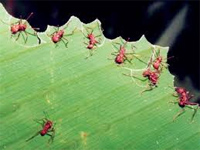 |
Leafcutters at Work |
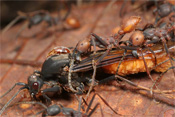 |
Army Ants Attacking a Wasp |
Most of the time, encountering Hymenoptera Formicidae is a benign event; we just amuse ourselves by watching their hyperactivity or are fascinated by types like the Leafcutter Ant, a very busy, non-aggressive little fella (except to plants).
But sometimes ants can be aggressive and when they are, they're no fun to be with. A few weeks ago I was just leaving the beach after another incredibly beautiful day in Manuel Antonio. I was waiting at the bus stop, peacefully sitting on a low cement wall with my sandaled feet resting on a pile of dead leaves.
After a minute or so I began to feel tiny creepy-crawly things running over both feet. Before I got a chance to reach down and brush the little devils away, the stings began, as if the varmints were in communication with each other (they were, according to the experts). As the level of pain increased, I jumped up and vacated the leaf area ending up on the other side of the street where the surface was only asphalt.
 |
Fire Ants |
For the next five minutes I slapped and swatted and brushed away as many of the critters as possible. The bus came and after I got on I was still trying to rid myself of these tiny black ants. On the bus, GG removed his sandals so I could get at the ones that had lodged under the sandal straps. The pain became quite strong and I longed to rub something soothing on the affected areas but had to wait until I got home. The sting would last for hours making a good night's sleep difficult.
Locals tell me what I encountered was a type of fire ant. I remember fire ants from Sarasota but I believe they were red not black up there. Regardless of their hue, they were just as painful here as there. The locals in Florida told me fire ants act in just the way I experienced here: first they swarm and then, by some form of signaling each other, they proceed to bite all at once. Clever buggers.
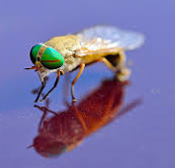 |
Greenhead Fly |
Gerry would have protected me from these rogues had they decided to come into the house. The experience at the bus stop and continued musing over Gerry's disappearance led me to wonder about ants in general and so I put Google to work.
A fire ant is roughly the same tiny size as a no-see-um (2- 5 mm or .08 - .2 inches). No-see-ums are those other little pesky creatures; tiny mosquitos, with a hefty bite. They're easily found on the Atlantic coast beaches.
But the worst beach pest in my experience is the Greehead fly, a nasty little fly that seems to stick to only the northeast U.S. beaches, such as Massachusetts where I grew up. This fly with the luminescent green head can be up to 28mm or 1-1/8 in. long and sports a large cerrated stinger that makes a victim feel like he's being stabbed with a small arrowhead. The sting is, in my opinion, worse than the fire ant but the only saving grace is that Greenheads don't usually attack in swarms and their larger size makes them more easily vulnerable to swatting.
 |
Paper Wasp |
While surfing around the net, I ran into an interesting article about a fellow named Justin O. Schmidt, an entomologist at the Carl Hayden Bee Research Center in Arizona. Schmidt has, for some years now, been attempting to quantify the level of pain humans experience from various insect stings. This effort resulted in a "Schmidt Sting Pain Index" which has a scale of 1 to 4.
Here are the values for selected insects according to the list so far evaluated: Schmidt Sting Pain Index for a Fire Ant = 1.2 (sure doesn't feel that low to me); Bees, Yellow jacket & Honeybee both = 2.0; Paper Wasp = 3.0 (nearly three times the fire ant - zowie!). GG didn't see a listing for a Greenhead but my guess is it would be in the 2-3 range.
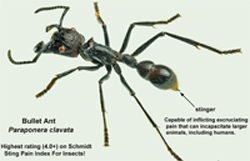 |
The Formidable and Dreaded Bullet Ant - Schmidt Sting Pain Index = 4+ |
But the king of the ant pain makers is a large one, the Bullet Ant (Paraponera Clavata) which is a full inch long or 5 times the length of a fire ant. It comes with a stinger in its rear and a Schmidt Sting Pain Index of 4+. I think I'd like to forego the pleasure of confirming that. The Bullet Ant, which is present in Costa Rica (but I've never seen one) is considered one of the five most horrifying bugs in the world.
The other top four world-class nasties are the Japanese Giant Hornet that can melt flesh with its venom, the Africanized Honeybee (also present in Costa Rica) that attacks in groups and can kill a person, the Army Ant (Amazon basin) with its massive, powerful, machete-like jaws half the length of the ant itself and the Bot Fly (Central and South America), the larvae of which can burrow under your skin and cannibalize your being. Charming bugs, eh?
So, be on the lookout for nasty bugs. The best defense from the worst of them is to run like hell. At any given moment there are an estimated 10,000,000,000,000,000,000,000 (that's ten billion billion) bugs in the world or 1.5 billion for each human inhabitant. The numbers alone warrant caution and respect.
But don't let the odds bug you.
¡Solo Bueno!
Journey of a Thousand Steps
(La Paz Waterfall Gardens)
Living in Costa Rica means that one must succumb to wanderlust because there are so many attractions that need to be investigated. So when one ROMEO suggested to GG that he had never seen the famous waterfalls at La Paz , GG was on board immediately as he hadn't seen them either. We decided to use the town of Alajuela as a jumping off point as La Paz is in Alajuela province. We made a reservation at a modestly priced hotel in the heart of the city, just a block and a half from the cathedral.
 |
So, on Friday the 13th of June, we took a bus from Quepos to San José at a senior discount of 25% off the regular fare; net 3,300 colones or about $5.90. This provided enough time for GG to follow up on an reading glasses prescription left over from his recent cataract surgery. The surgery left him with 20/20 perception in the distance but still with a slight astigmatism for up close reading. So a quick cab ride from the bus terminal dropped us off at Hospital Calderon Guardia.
After finding the proper office, GG's prescription was processed and he was given a date of July 20 to pick up the eyeglasses. Not exactly one hour processing like some places in the States but the total cost was 5,300 colones or about $10. The same glasses quoted at a private optical store in Quepos would have cost 70,000 colones, so the trip was worth it. As a friend of mine, a dude in the printing business, used to say: "Price, Quality, Service, choose any two".
After completing the business with the glasses for now, we decided lunch was in order and took a quick cab ride to the center of San José, deciding along the way to eat at the restaurant at the National Theater. We had both been there before and liked it and today was no exception (see ROMEO Review section below). After lunch and the obligatory POPS ice cream cone for desert from the ice cream store situated only 20 meters from the restaurant (irresistible magnetic pull), we took a quick cab ride to San Jose's Alajuela terminal near Parque Merced. From there the bus ride got us into central Alajuela in 25 minutes (normally 515 colones or about a buck, but with a residency card and 65 or more years of occupancy on the planet it's free).
 |
Alajuela Product |
We signed up for the La Paz tour at the hotel and were picked up by a van the next morning at 11. The trip north to mountain country is about 30 kilometers or 18 miles and takes about one hour. We passed through very green country and learned the area is best known for its agricultural products, namely strawberries, coffee and flowers.
We changed vans about half way up the mountain at which point they suggested we might want to purchase a rain poncho (after all, it is the rainforest, they pointed out). GG declined, relying on the umbrella he brought. As it turned out, the day was overcast but punctuated only by a couple of very light showers; nothing like the typical Costa Rican downpour.
The entrance to La Paz is situated near the top of one of the mid-sized mountains north of Alajuela. The park is a privately owned reserve sanctioned by the government and comprises about 28 hectares or 70 acres on a mountain side where elevation at the top is 1,580 meters (5,225 feet). The trails wind down the mountain to the base of the waterfalls at 1,270 meters (4,200 feet).
 |
"Magia Blanca" Waterfall -La Paz Note Viewing Platform Lower Left |
There are five waterfalls to see, all approachable by a series of stone walkways with fixed handrails made of tough (rock-like) thick vines from the jungle and containing more than the 1,000 steps mentioned in the title above. Each of the waterfalls has viewing platforms for admiring the waterfall and taking pictures.
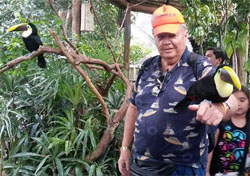 |
GG and His New Tucan Friends |
One winds down the stone stepped paths on the way to the waterfalls and passes through an aviario (with Toucans, Wild Turkeys, Scarlet Macaws, Emerald Macaws, Grosbeaks, Tanagers, Carraras and many more types).
GG got a chance to talk with a chestnut-billed tucan who perched on his arm, looking for a handout which I didn't have (see picture left).
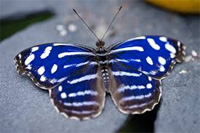 |
Butterfly of a Different Stripe |
 |
Tico Jaguar, the Biggest Wildcat in Costa Rica |
 |
Not a Nice Fella |
 |
Typical Walkway at La Paz |
Besides the aviary, there are many other things to see, e.g.: a) a colibries aviary for hummingbirds only, b) a mariposario (a fluttering butterfly collection ranging from monarchs to morphos, c) a felinos area where there are 5 of the known 6 wildcats of Costa Rica, d) a selection of orchideas or orchids, e) an exhibit of monkeys containing all four types found in the country (Spider, White-Faced, Squirrel and Congo), f) a ranario or frog collection and exhibit and g) a serpentario or snake collection (can give you the willies).
There is also a fern trail and trout lake which we didn't get to see.
By the time we traversed most of these exhibits it was time for lunch. We were treated to a buffet that included a very large selection of goodies; there was enough of a wide variety of items to please any palate and whim.
After lunch we finished off the last few exhibits and ended up at the head of a stone stairway that looked like it headed down into the netherworld. "There are 768 steps to the waterfalls", the guide announced proudly. I don't think I can make it back up with these knees says GG. Not to worry, says the guide, there will be a van down there that will pick you up. With that, the two old ROMEOS headed down the path towards hades. What the guide didn't mention was that once we had gotten to the falls at the bottom there would be another 200-300 steps in a different direction, uphill to get to the station where the van was parked.
We returned to Alajuela exhausted but pleased by a very interesting and beautiful afternoon. Our tour, including transportation from our hotel, lunch and the guide was $80 apiece. If you provide your own transportation, the entrance fee is $38 for adult "foreigners" (add $13 for lunch) and $22 plus $7 for each child. Locals and residents (like us) pay $22 entrance plus $13 for lunch (children are $13 + $7). The two ROMEOS agreed that the tour and experience were well worth the fees and charges.
So, if you haven't been to this attraction yet and would like to acquaint yourself with Costa Rican wildlife and rainforest beauty, visiting La Paz is an excellent way to do it.
¡Viva La Paz!
Travel Quote of The Month |
“I can’t think of anything that excites a greater sense of childlike wonder than to be in a country where you are ignorant of almost everything. Suddenly you are five years old again. You can’t read anything, you have only the most rudimentary sense of how things work; you can’t even reliably cross a street without endangering your life. Your whole existence becomes a series of interesting guesses.” – Bill Bryson |
What's-in-a-Word
Gecko
The New Latin gekko and English "gecko" stem from the Indonesian-Malay gēkoq, which is imitative of the sound the animals make. (Maybe, if your Indonesian, but to me it sounds like thwack, thwack, thwack)
Catarata
This is the Spanish word for waterfall. It also happens to be the Spanish word for cataracts, like the ones GG had removed. As I've said before, Spanish can be very flexible.
ROMEO Corner
(Retired Old Men Eating Out)
Alma de Café, San José
 |
Teatro Nacionál |
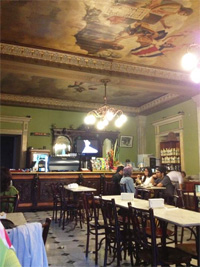 |
Alma de Café |
Location: Inside the Teatro Nacionál, San José centro.
Hours: Breakfast/Lunch/Light Dinner
Parking: Good luck, find a pay-lot nearby.
Contact: Tel.: 2221 1329; Email: info@almadecafe.net; Website: www.almadecafe.net.
Reviewing ROMEOS: Brian M., Bob N.
To Review Our Rating System and Procedure, go here: R.O.M.E.O. Rating System
Both ROMEOS had eaten here before and enjoyed it every time. This is probably the easiest restaurant in the city to find because it's dead center San José and inside the national theater, a well known landmark. If you haven't seen this building, in all it's neo-classical glory, just walking through it is more than interesting.
The decorative art work on the ceilings and walls of the theater carries through to the Café, which is easily located through the main entrance to the theater and immediately to the left. The tables are simple but marble topped, continuing the victorian theme.
If you sit near a window you can see the bustling square in front of the teatro or the kids feeding the pigeons in the Plaza de la Cultura. The place is frequented by local office workers, politicians and, of course, tourists like us.
For atmosphere we give Alma de Café (translates literally as "Soul of Coffee") five sloths.
Alma de Café specializes in two things: light fare consisting of sandwiches, salads and crepes and, in true coffee house fashion, rich desserts. GG had a multigrain, veggie-stuffed pita sandwich, that seemed to have a whole avocado in it. Delicious, especially when accompanied by a strawberry and passion fruit smoothie. Brian chose a club sandwich which looked to me to have been as big as any I've ever seen and by the sounds coming from the opposite side of the table, I guess it tasted good also. We didn't try any of the huge desserts at the Café on this trip (we settled for a POPS ice cream cone afterwards) as we're both trying to cut down on sugar. In the past I've had chocolate creations there that could only be described as sinful. We give Alma de Café five sloths for food quality. |
 |
|---|---|
$$$$ |
|
Value Index = 125 |
Service was prompt, friendly and courteous. What else do you want out of a restaurant? Our overall rating for Alma de Café for atmosphere, food quality and service is five sloths.
For our large sandwiches, and one fruit drink we averaged about 5,500 to 6,000 colones each or about $10-11 per tab. This puts the Café in the low end of our four $ rating. That gives the restaurant a Value Index of 5/4x100 = 120, which puts it in the top third of restaurants we've rated for value.
So, if you're in San José, this is a lunch place you definitely should treat yourself to; and don't overlook the desserts.
don Beto de Quepos,
El Gringo Dorado Pura Vida! |
Be pithy but kind. I'm sensitive. |
|---|








